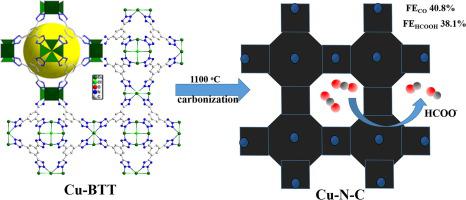Journal of Energy Chemistry ( IF 13.1 ) Pub Date : 2020-06-26 , DOI: 10.1016/j.jechem.2020.06.038 Si-Min Cao , Hua-Bo Chen , Bao-Xia Dong , Qiu-Hui Zheng , Yan-Xia Ding , Meng-Jie Liu , She-Liang Qian , Yun-Lei Teng , Zong-Wei Li , Wen-Long Liu

|
Cu-based MOFs, i.e., HKUST-1, etc., have been pertinently chosen as the pristine materials for CO2ER due to the unique ability of copper for generation hydrocarbon fuel. However, the limited conductivity and stability become the stumbling-block that prevents the development of it. The exploring of MOFs-derived M−C materials starts a new chapter for the MOFs precursors, which provides a remarkable electronic connection between carbon matrix and metals/metal oxides. N-doped M−N−C with extensive M−N sites scattering into the carbon matrix are more popular because of their impressive contribution to catalytic activity and specific product selectivity. Nevertheless, Cu–N–C system remained undeveloped up to now. The lack of ideal precursor, the sensitivity of Cu to be oxidized, and the difficulties in the synthesis of small size Cu nanoparticles are thus known as the main barriers to the development of Cu–N–C electrocatalysts. Herein, a nitrogen-rich Cu–BTT MOF is employed for the derivation of N-doped Cu–N–CT composite electrocatalysts by the pyrolyze method. High-temperature pyrolysis product of Cu–N–C1100 exhibits the best catalytic activity for productions of CO (−0.6 V vs. RHE, jCO = 0.4 mA/cm2) and HCOOH (−0.9 V vs. RHE, jHCOOH = 1.4 mA/cm2).
中文翻译:

富氮金属-有机骨架介导的Cu–N–C复合催化剂用于电化学还原CO 2
铜基MOF(即HKUST-1等)已被适当地选择作为CO 2的原始材料由于铜具有产生碳氢化合物燃料的独特能力,因此具有ER。但是,有限的导电性和稳定性成为阻碍其发展的绊脚石。对源自MOF的M-C材料的探索为MOF的前体开辟了新篇章,这为碳基质与金属/金属氧化物之间的非凡电子连接提供了新的篇章。氮原子掺杂的M-N-C具有广泛的M-N位点散布到碳基质中,由于它们对催化活性和特定产物选择性的显着贡献而受到欢迎。然而,到目前为止,Cu-N-C系统仍未开发。因此,理想的前驱体的缺乏,铜被氧化的敏感性以及小尺寸铜纳米颗粒的合成困难被认为是发展铜-碳-碳电催化剂的主要障碍。在这里通过热解法制备T复合电催化剂。Cu–N–C 1100的高温热解产物对产生CO(-0.6 V vs. RHE,j CO = 0.4 mA / cm 2)和HCOOH(-0.9 V vs. RHE,j HCOOH)表现出最佳的催化活性。 = 1.4 mA / cm 2)。



























 京公网安备 11010802027423号
京公网安备 11010802027423号